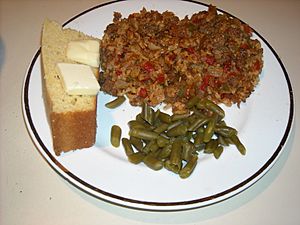Hash (food) facts for kids

Hash is a yummy dish made from chopped meat, potatoes, and fried onions. The word 'hash' comes from the French word hacher, which means 'to chop'. People first made hash to use up leftover food. In the United States, around the 1860s, cheap restaurants were even called 'hash houses'!
Canned corned beef hash became super popular in places like Britain, France, and the United States during and after World War II. This was because rationing limited how much fresh meat people could get.
You can eat hash for breakfast, lunch, or dinner. When served for breakfast in the United States, hash often comes with eggs, toast, or even baked beans. Fancy restaurants sometimes offer special hash dishes. Modern hash can be made with different meats like lamb, fish, turkey, or even shrimp!
Hash in the United States
Hash has been a part of the American diet since at least the 1700s. Many recipes and "hash houses" show how popular it was. In the United States, September 27 is even "National Corned Beef Hash Day."
Classic American corned beef hash started in the New England area. It was a way to use leftovers from a traditional meal of beef, cabbage, potatoes, and onions. A special kind called "red flannel hash" uses beets instead of potatoes. People in New England also made fish hash, including one with salted cod.
Eating corned beef and cabbage is an Irish-American tradition. It's now common across the United States on Saint Patrick's Day. Corned beef hash is also often served on St. Patrick's Day. It's also popular around American Thanksgiving and Christmas.
In the Midwest, people often used a white sauce to hold hash together.
In the southern United States, "hash" can mean two different dishes:
- A traditional Southern mix of leftover pork from a barbecue. It's mixed with barbecue sauce and served over rice. This is a common side dish at barbecue restaurants. You'll find it especially in South Carolina and Georgia.
- In Texas, it's a thick stew made from pork, chicken, and beef. It's seasoned with salt, pepper, and other spices. This stew is cooked slowly overnight over an open fire in a large iron pot.
Some areas in the South also use the word hash for meat like wild game. This meat is served as barbecue or pulled meat that was boiled first.
Hash in the UK
As early as the 1300s, English people were making a dish called hache or hachy. A famous English writer named Samuel Pepys wrote about how much he loved a rabbit hash in 1662.
An 18th-century recipe for "excellent hash" used a seasoned sauce with herbs and onion. It also had cayenne pepper, mace, and nutmeg. Then, broth or gravy was added, along with mushroom catsup. Cold beef would gently cook in this sauce. Simpler recipes would skip some fancy ingredients. They would add root vegetables like carrots and boiled potatoes to make it more filling.
"Norman hash" was a dish of gravy and onions served over slices of leftover roast beef.
Hash in Other Countries
In Denmark, hash is called "biksemad." This means "tossed together food." It's a traditional leftover dish, usually made with pork, potato, and onion. It's served with a fried egg, Worcestershire sauce, pickled red beet slices, and ketchup. The ingredients are cut into chunks, so you can still see them. A beef version is called "Royal hash."
In Sweden, there's a hash called pyttipanna. It's similar to the Danish version. Finland has "pyttipannu," and Norway has "pyttipanne." A Swedish type called Pytt Bellman uses beef and adds cream to the hash. It's named after a famous Swedish poet, Carl Michael Bellman.
In Austria, especially in Tyrol, there's a similar dish called "Gröstl." It usually has chopped leftover meats (often pork sausage), potato, and onions. These are fried with herbs like marjoram and parsley. It's often served with a fried egg on top.
In Slovenia, it's called haše. It's often used as a spaghetti sauce. It's made from minced pork and veal, potato sauce, onion, garlic, flour, and spices.
In Spanish, Portuguese, and Latin American cooking, there's a similar dish called picadillo (Spanish) or carne moída (Portuguese). It's made with ground meat (usually beef) and tomatoes. Vegetables and spices change depending on the region. It's often served with rice or used as a filling for dishes like tacos or tostadas. The name comes from the Spanish word picar, which means "to mince" or "to chop."
In Germany, Labskaus is made with beef or corned beef. It's minced with onions and boiled potatoes, then fried in lard. Beetroot and herring can be added or served on the side.
See also
 In Spanish: Hash (carne) para niños
In Spanish: Hash (carne) para niños


